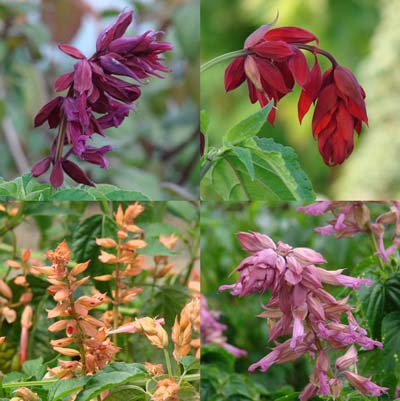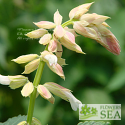Bedding Plant Royalty: Splendid Salvia Splendens

If the world were to coronate a Salvia as its favorite annual, there's little doubt that a deep red variety of Scarlet Sage ( Salvia splendens) would bear the sceptre. It's a global favorite garbed in lush foliage and flower spikes thick with blossoms from late spring until frost.
Yet S. splendens is such a popular species that many people simply call it the commonest of common names -- Bedding Sage or Red Sage. When it was first introduced to horticulture in 1822, it was known as Lee's Scarlet Sage.
Containers, Massed Plantings and Mixed Borders
Nowadays, Scarlet Sage is available in a broad array of colors: blues, burgundies, lavenders, oranges, pinks, reds and bicolors. The leaf-like bracts supporting its tubular blossoms are equally colorful.
Depending on the cultivar, the flowers of Scarlet Sage can be up to 2 inches long. Veined and ovate, the leaves have serrated edges and grow up to 3 inches long. Foliage ranges from dark green with a hint of blue to greens so bright they are called yellow. Some cultivars are dramatically variegated.
Although the species grows several feet tall in the wilds of its Brazilian homeland, it has been so heavily hybridized that most varieties are short. Commercial Scarlet Sages can rise up less than a foot to well over 3 feet (Salvia splendens 'Giant Form' is one of the tallest). However, they are generally about 2 feet tall or less.
Scarlet Sage is harmonious in mixed borders and containers. Single varieties often are massed in broad swaths of bold color. Being less than tempting to deer, most varieties suffer little from browsing.
Moisture and Other Basics
Scarlet Sages love moisture yet thrive on average supplemental watering based on local rainfall and humidity. Most are partial shade plants with many growing well in morning sun and afternoon shade. Although easy to grow, Scarlet Sages do require a rich, well-drained growing medium, such as loamy garden soil.
Roots of Scientific and Common Names
As its scientific name indicates, S. splendens is a splendid species. Its species name also means "bright" or "shining."
The long form of its botanical name, S. splendens Sellow ex Schult., indicates that the German botanist who discovered the plant -- Friedrich Sellow (1789-1831) -- was the first person to describe and name it scientifically for publication.
Partly to avoid Europe's turmoil following the French Revolution and at the onset of the Napoleanic Wars, Sellow joined a Russian plant expedition to Brazil in 1814. He stayed 17 years until his death there crossing a river.
Who doesn't hate paperwork, even the digital kind? It isn't hard to imagine that Sellow preferred the hot, dusty, demanding work of plant exploration to the expensive, tedious process of plant publication. Something was incorrect in his application for the plant's name and was corrected by his contemporary, Austrian botanist Josef August Schultes (1773-1831). This explains the "ex Schult." tagged to the end of the plant's name.
As to "Lee" in the first common name, he was a grower at the Vineyard Nursery in Hammersmith, England, which counted Napoleon Bonaparte's wife, the Empress Josephine, among its clientele. The mysterious Mr. Lee most likely was a son of one of the garden center's founders, James Lee (1715-1795).
The Vineyard, which no longer exists, is considered to have been one of the world's first commercial nurseries. It is also the establishment that introduced Scarlet Sage to horticulture in 1822.
The English weren't the only 19th century growers entranced by the possibilities of Scarlet Sage. Cultivars with "van houttei" in their name are actually varieties of S. splendens 'Van Houttei' and include some of the most spectacular descendants of that cultivar. They are, ultimately, attributable to Louis Benoit Van Houtte (1810-1876), who is considered the father of Belgian horticulture.
Splendor in the FBTS Gardens
Although we recommend growing Scarlet Sage as an annual, it is also considered a tender perennial and may, on occasion, winter over in USDA Plant Hardiness Zones 9 to 11.
Similar to common species of the world's favorite shade annual, Impatiens, Scarlet Sage has been hybridized so many times that it is impossible to keep up with all the varieties. The solution, at least for Flowers by the Sea, is to offer what we consider to be the best types.
By best, we mean that these plants are easy to grow, vigorous, attractive to hummingbirds and distinctive. Their flowers and foliage are singular within the crowd. Here are some favorites.
Burgundy Scarlet Sage (Salvia splendens van houttei 'Burgundy')
- Burgundy flowers
- Mid-green foliage
- 24 inches tall and wide
Dancing Flame Scarlet Sage (Salvia splendens van houttei 'Dancing Flame')
- Deep orange-red flowers
- Bright yellow foliage mottled with green
- 24 inches tall and wide
Sao Borja Scarlet Sage (Salvia splendens 'Sao Borja')
- Smoky purple flowers
- Bright green foliage
- 60 inches tall in bloom, 48 inches wide
Faye Chapel Scarlet Sage (Salvia splendens van houttei 'Faye Chapel')
- Scarlet red flowers
- Blue-green foliage
- 48 inches tall in bloom, 36 inches wide
Elk White Scarlet Sage (Salvia splendens van houttei 'Elk White')
- White flowers and creamy bracts with rose blush
- Blue-green foliage
- 60 inches tall in bloom, 24 inches wide
Time to Plant Joy & Grandeur for Hummingbirds
Now that the growing season is about to bloom anew, it's time to plant annuals to feed hummingbirds. Scarlet Sages and other Salvias help set a grand, colorful banquet for these tiny pollinators. When you see them pause at flowers you planted, it's difficult not to be proud of your efforts and feel joy about being alive.
If you have questions about any of our plants or garden planning, we're glad to answer. Please contact us at FBTS so we can help you create a joyful landscape.
While you're studying our online catalog, here's a bit of music for positive thinking: We'd like to introduce you to a different kind of Red Sage in the following video -- a Denver band that sings "It's Good to Be Alive."

 Salvia splendens van houttei 'Elk White'
Salvia splendens van houttei 'Elk White'  Salvia splendens van houttei 'Faye Chapel'
Salvia splendens van houttei 'Faye Chapel'  Salvia splendens 'Sao Borja'
Salvia splendens 'Sao Borja'  Salvia splendens van houttei 'Dancing Flame'
Salvia splendens van houttei 'Dancing Flame'  Salvia splendens van houttei 'Burgundy'
Salvia splendens van houttei 'Burgundy'
Comments
There are no comments yet.